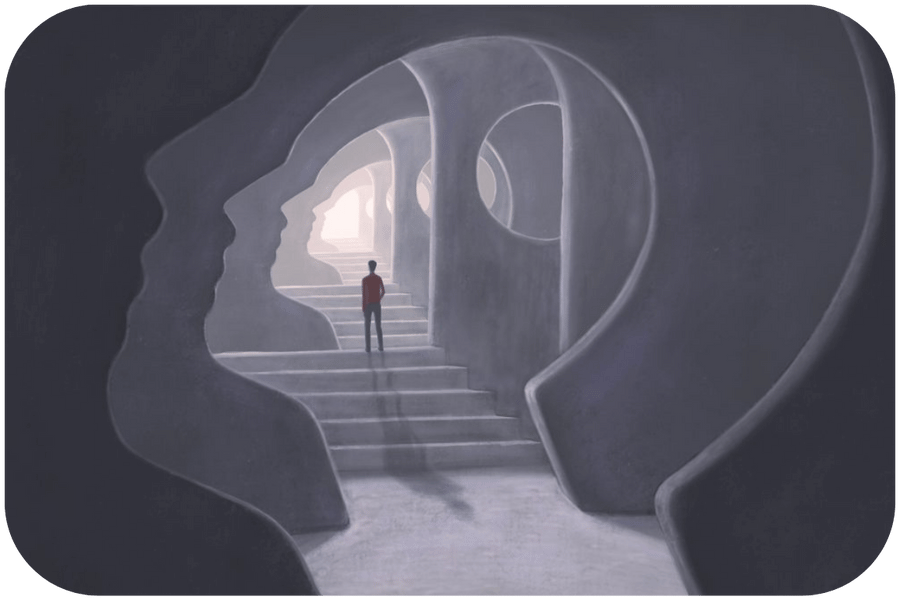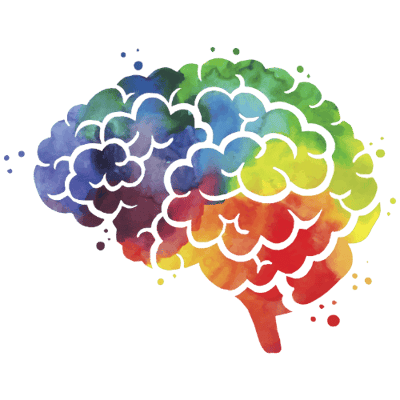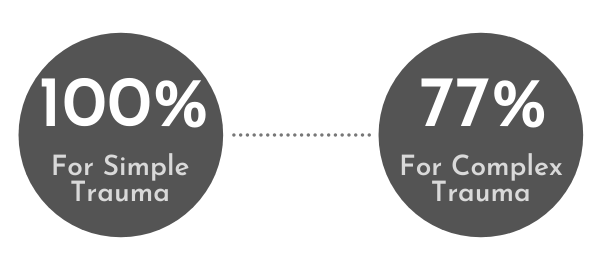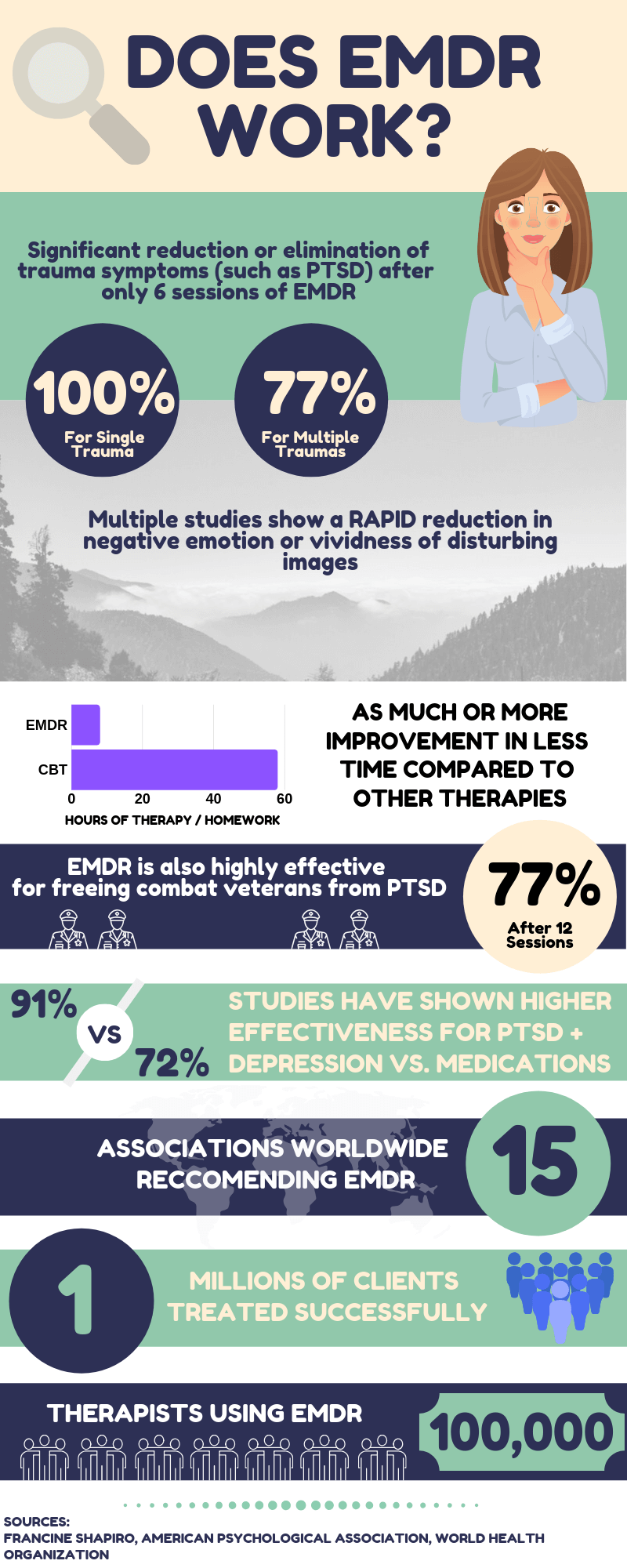EMDR Therapy
Work through painful past experiences and take steps toward healing

EMDR Therapy
EMDR Therapy is a highly effective approach that helps you transform the way you experience and respond to distressing life events.
By working with a certified therapist in a safe, supportive environment, you can process painful memories, reduce the emotional charge they hold, and begin to see yourself and your experiences in a new, more empowering light.
Over time, this therapy not only eases distress, but can also help you build greater resilience and regain a sense of calm and control in your daily life.

Transform painful memories & feelings
Learn to reprocess difficult experiences so they feel less overwhelming.
Reduce vividness of past traumas
Lessen the intensity of distressing memories through guided techniques.
Relieve psychological stress
Build healthier coping responses to feel calmer and more grounded
Traumatic events can take many forms, changing the way you experience daily life, and may lead to PTSD
These events can be anything that has left a lasting impression on you and has been very difficult to move past

Childhood Trauma

Emotional Abuse

Physical Abuse

Sexual Abuse

Death of Loved One

Serious Injury

Auto Accident

Natural Disaster
Common Symptoms of Trauma

- Anxiety and Fear
- Guilt and Shame
- Withdrawing from others
- Feelings of Hopelessness
- Lack of Joy in Things that Used to Bring Happiness
- Sadness
- Anger, Irritability, Mood Swings
- Difficulty Concentrating
- Trouble Sleeping
- Feeling disconnected from everyday life
Trauma can be difficult to address on your our own as our brain tends to re-live and ‘loop’ through the most distressing part of the traumatic event. It can become difficult to feel a sense of safety and be able to work through these memories and symptoms without help.
EMDR Therapy – Efficient, Focused, Effective
Backed by research as a therapy that may shorten the path to relief


Research shows that EMDR Therapy can lead to meaningful relief from trauma in a relatively short time. Many people see a noticeable reduction in symptoms—such as anxiety, distress, or intrusive memories—after just a few sessions.
Clinical studies also highlight that EMDR can help ease the emotional intensity and vividness of painful memories, making it easier to move forward without feeling weighed down by the past.
Everyone’s healing journey is unique, but these results suggest EMDR is a powerful and efficient tool for those seeking to address trauma and emotional challenges.
Comparable—or even greater—positive change compared to other therapeutic approaches
.png?width=250&height=250&name=Untitled%20design%20(26).png)
.png?width=300&height=300&name=Untitled%20design%20(27).png)
Lets us Help you Find the Right Match
Trusted by Mental Health Professionals Worldwide



How Does EMDR Work?
A painful memory can stay with you and continue to bring up distressing thoughts or feelings, like “I’m not good enough” or “I’m not safe.” EMDR helps by gently bringing this memory into your working memory, where you can process it in a new way.
Through guided eye movements—or other forms of bilateral stimulation—your brain has a chance to work through the emotions tied to this experience.
Over time, the memory starts to lose its intensity and becomes less upsetting, helping you carry it with greater ease and self-compassion.
FAQs
EMDR stands for Eye Movement Desensitization and Reprocessing. EMDR was discovered by chance by Francie Shapiro in the 1980’s. On a walk Francine realized that the thoughts around a disturbing memory she had had suddenly disappeared. Fascinated by this, she started paying close attention to what she was doing.
She realized that when she brought up distressing memories her eyes started moving back and forward. By chance, she realized that her eye movement was the reason she become desensitized to her disturbing memories.
She started off with EMD (Eye Movement Desensitization) and later added the R for Reprocessing. Her further studies realized the therapy is not just about desensitizing but also reprocessing the events and feelings as a whole.
She later stated that she would have just called it “Reprocessing Therapy”, but that name stuck after so many years.
No, EMDR does not involve hypnosis. The goal of hypnosis is to have the persons attention so focused that while in a state of hypnosis, anything going on around the person is temporarily blocked out or ignored. This is not the case in EMDR, in EMDR you are aware of what is going on around you and you are not in an altered state.
EMDR was originally developed to reduce the symptoms of post traumatic stress disorder (PTSD). EMDR has been widely researched as effective for PTSD and trauma with up to 100% effectiveness for single trauma and 77% effective for those with multiple traumas.

There is ongoing and promising research suggesting that EMDR is helpful in treating anxiety and depression.
While EMDR cannot take away the natural process of grieving, it can help soften the emotional weight of difficult memories. This makes it easier to manage intense feelings and begin to find healing and meaning after a loss.
EMDR allows for your brain to go deeper and work through more than traditional talk therapy can.
It allows for your brain to experience a more thorough healing and become “unstuck”. This is achieved by helping your brain make more connections than talk therapy.
EMDR does not mean that you won’t engage with your therapist as in ‘talk therapy’. In fact, talk therapy is used in conjunction with EMDR.
It was eventually discovered that eye movement is not the only way to allow the brain to process information.
The eye movement actually creates movement between the left and right hemisphere of the brain. This back and forward process, or bilateral movement in the brain, is believed to be what is required for processing and desensitization
This Bilateral stimulation can be achieved with the traditional eye movements, but also with touch and sound.
The therapist will either tap on a clients knees (if they are comfortable) or use EMDR pulsers that they hold in their hands.
For auditory stimulation the client wears headphones that make alternating beeps from left to right ear.
There has been major leaps in the understanding of neurobiology, the full understanding of why it works is still being researched.
At this point, the best explanation relates to the eye movement we naturally make to process information when we are sleeping.
When in a deep dream state our eyes make the same movement that is used in EMDR, This movement is called REM sleep. This eye movement creates Bilateral stimulation in the brain.
Repeated traumatic childhood experiences can often carry a emotional heaviness that follows us as we grow.
Children need to feel loved by their parents, they are sensitive to their parents perception of them and overly critical parents can leave their children questioning whether they are lovable.
We can love our parents and at times reflect back on our childhood feeling like we had unmet childhood needs or resentment for how we were treated.
On the other hand, it is common try to manage our feelings by minimizing our experience, you tell yourself that you should just be able to “get over it” by now, it was “not that bad”, or your parents are “different now”. These are common misconceptions about the serious impact that adverse childhood experiences can have on us.
Whether you are wanting to address complex trauma in general or complex trauma related to childhood events, it can feel overwhelming to think about how to address such long standing traumatic events.

Last Reviewed Aug 5 2025 by Devon Jorge
Devon is an EMDR Certified Therapist (EMDRIA) and has completed additional training for complex trauma and the use of EMDR. Devon has a Masters Degree in Social Work from Wilfred Laurier University and is a designated Registered Social Worker (MSW, RSW) - Psychotherapist. Devon has experience treating individuals, couples, families in both private practice and agency settings and has also worked internationally.
Not sure yet? Let’s talk it through.
If you’d like to ask questions or explore your options first, book a free 20-minute matching consult or give us a call (226-752-8857) . One of our team members will help you find the right therapist and next steps that feel comfortable for you.
%20(1).png?width=200&height=80&name=Trillium%20Counselling%20Logo%20(999%20x%20398%20px)%20(1).png)

















